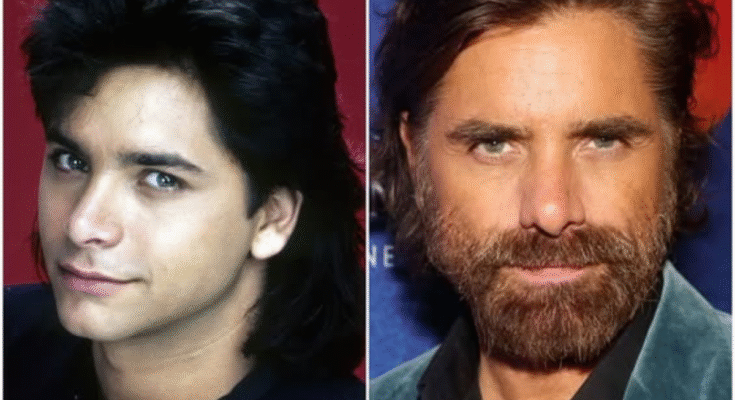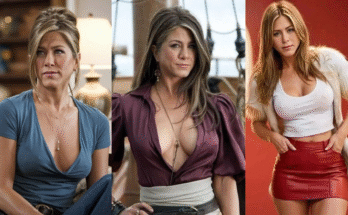The remarkable journey of John Phillip Stamos, from aspiring musician to teen heartthrob to beloved television patriarch
Introduction: More Than Just a Pretty Face
John Phillip Stamos has spent over four decades in the entertainment industry, evolving from a teen heartthrob on daytime television to one of America’s most enduring and versatile performers. His journey from a young man with musical dreams in Orange County, California, to becoming Uncle Jesse and later a respected actor, producer, and cultural icon represents a masterclass in career longevity and artistic evolution.
What sets Stamos apart from many of his contemporaries is his ability to embrace different phases of his career while maintaining his essential charm and authenticity. From his early days as Blackie Parrish on “General Hospital” to his iconic role as Jesse Katsopolis on “Full House” and beyond, Stamos has consistently demonstrated that true star power comes not from avoiding typecasting, but from bringing depth and genuine emotion to every role.
His story is one of persistence, reinvention, and the courage to take creative risks while honoring the work that made him famous. Through personal challenges, professional setbacks, and triumphant comebacks, Stamos has maintained his position as a beloved figure in American entertainment while continuing to grow as both an artist and a person.
Chapter 1: Roots and Early Dreams (1963-1982)
Greek Heritage and Family Foundation
John Phillip Stamos was born on August 19, 1963, in Cypress, California, to William “Bill” Stamos and Loretta (Phillips) Stamos. His father, a first-generation Greek-American, owned and operated several restaurants, instilling in John a strong work ethic and an appreciation for hospitality and connecting with people—qualities that would serve him throughout his entertainment career.
Bill Stamos had immigrated from Greece and built a successful restaurant business through determination and hard work. He taught his children the value of perseverance and the importance of treating everyone with respect, regardless of their background or status. These lessons would become fundamental to John’s approach to his career and his relationships with fellow performers and crew members.
John’s mother, Loretta, provided the family’s artistic influence. Her appreciation for music and performance encouraged John’s early interest in entertainment, while her nurturing nature helped balance his father’s business-minded pragmatism. This combination of creative support and practical guidance created an ideal environment for John’s artistic development.
The Stamos household was one where Greek traditions were honored and celebrated, giving John a strong cultural identity that would later influence his career when Jesse Katsopolis’s Greek heritage was written into “Full House” to accommodate his own background. This cultural pride became an integral part of his public persona and personal identity.
Musical Beginnings and Early Talents
From an early age, John demonstrated a natural affinity for music, particularly drumming. His parents recognized his talent and supported his musical education, understanding that creative expression was essential to his happiness and development. His drum skills would later become crucial to his “Full House” character and his real-life musical collaborations.
During his elementary and middle school years, John participated in school bands and local musical groups, developing not only his technical skills but also his comfort with performing in front of audiences. These early experiences taught him about teamwork, timing, and the thrill of live performance.
His musical interests weren’t limited to drumming—he also experimented with other instruments and developed an appreciation for various musical styles, from rock and pop to the classic sounds that would later influence his work with The Beach Boys. This broad musical education gave him a foundation that would serve him throughout his career.
High School Years and Growing Ambitions
At John F. Kennedy High School in La Palma, California, John’s charisma and good looks made him popular among his classmates, but it was his genuine personality and musical talents that truly set him apart. He participated in school productions and continued developing his performance skills while maintaining strong academic performance.
During these years, John began seriously considering a career in entertainment. His natural comfort in front of audiences, combined with his musical abilities and photogenic appearance, suggested that he might have the qualities necessary for professional success in the highly competitive entertainment industry.
His high school experience also taught him about balancing multiple commitments—academics, music, social relationships, and part-time work in his father’s restaurant. This early lesson in time management and priority setting would prove invaluable during his later career when he would need to juggle multiple projects and commitments simultaneously.
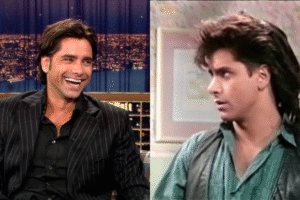
Early Career Exploration and Modeling
After graduating from high school, John began exploring professional opportunities in entertainment. His striking appearance and natural charisma led to modeling work, which provided him with his first professional experience in front of cameras and taught him about the commercial side of the entertainment industry.
These early modeling assignments were crucial learning experiences, teaching John about professionalism, punctuality, and the importance of maintaining his appearance and health for career purposes. He also learned about the business aspects of entertainment—contracts, agents, and the importance of building professional relationships.
The modeling work also introduced John to the entertainment industry’s social scene, where he began making connections that would prove valuable throughout his career. His natural ability to connect with people and his genuine interest in others helped him build a network of professional relationships based on mutual respect rather than mere self-interest.
Chapter 2: Soap Opera Stardom and Early Success (1982-1984)
Landing General Hospital
John’s breakthrough came in 1982 when he was cast as Blackie Parrish on the ABC soap opera “General Hospital.” This role represented a significant leap from modeling to serious acting, requiring him to develop dramatic skills and learn the demanding pace of daily television production.
The casting process for “General Hospital” was competitive, but John’s natural charisma and his ability to convey both vulnerability and strength made him an ideal choice for the troubled Blackie Parrish character. The role required him to portray complex emotional situations and develop ongoing storylines that would span months or years.
Working on “General Hospital” provided John with invaluable training in television acting. The soap opera format demanded quick memorization, emotional availability, and the ability to maintain character consistency across hundreds of episodes. These skills would prove essential throughout his later career.
Character Development and Storyline Impact
Blackie Parrish was a character with significant dramatic potential—a troubled young man from a difficult background who was trying to find his place in the world while dealing with complex family relationships and romantic entanglements. This role allowed John to demonstrate his range as an actor beyond his good looks and charm.
The character’s musical interests provided John with opportunities to incorporate his real musical talents into his performances, creating authentic moments that resonated with audiences and established his credibility as a performer rather than just a pretty face.
His storylines on “General Hospital” often involved intense emotional situations—family conflicts, romantic complications, and personal crises that required him to access genuine emotions and convey them convincingly to audiences. This dramatic training would later enhance his comedic performances by providing him with a foundation of emotional truth.
Teen Heartthrob Status and Fan Following
John’s work on “General Hospital” quickly established him as a teen heartthrob, attracting a devoted fan following that appreciated both his appearance and his acting abilities. This early experience with fame taught him about the responsibilities that come with public recognition and the importance of maintaining positive relationships with fans.
The fan attention was intense and sometimes overwhelming, requiring John to learn how to balance accessibility with privacy. He developed strategies for interacting with fans that were both genuine and professional, skills that would serve him throughout his career as his fame continued to grow.
His teen heartthrob status also introduced him to the entertainment media’s attention, teaching him about interviews, photo shoots, and the importance of maintaining a positive public image. These early lessons in media relations would prove valuable throughout his long career.
Professional Growth and Industry Recognition
During his time on “General Hospital,” John received recognition from both audiences and industry professionals for his acting abilities. His work earned him nominations for soap opera awards and established his reputation as a serious actor rather than just a model-turned-performer.

The demanding schedule of soap opera production taught John about professionalism, preparation, and the importance of supporting his fellow actors. He developed a reputation for being easy to work with and committed to the quality of the show, qualities that would make him attractive to future casting directors and producers.
His success on “General Hospital” also provided him with financial stability and industry connections that would prove valuable as he considered his next career moves. The show served as an excellent launching pad for transitioning to other types of television and film work.
Preparing for Transition
As John’s time on “General Hospital” progressed, he began considering opportunities to expand his career beyond soap operas. His musical interests remained strong, and he began exploring possibilities for incorporating music into his acting career or pursuing music as a separate creative outlet.
The experience of playing Blackie Parrish had taught him about character development, emotional honesty, and the technical aspects of television production. He felt ready to take on new challenges that would allow him to grow as a performer while building on the foundation he had established.
His departure from “General Hospital” in 1984 was bittersweet—he was grateful for the opportunities and training the show had provided, but he was also excited about exploring new creative possibilities and taking his career in different directions.
Chapter 3: The Full House Years – Becoming Uncle Jesse (1987-1995)
Transitioning to Comedy
When John joined the cast of “Full House” in 1987, he was making a significant career transition from drama to comedy. The role of Jesse Katsopolis required different skills than his soap opera work—comedic timing, ensemble playing, and the ability to balance humor with heart in family-friendly storylines.
The character of Jesse was initially conceived as a more stereotypical “cool uncle” figure, but John’s natural charisma and musical abilities allowed the writers to develop the character in more complex and interesting directions. His Greek heritage was written into the character to accommodate his own background, creating authentic cultural elements that enriched the show.
John’s comfort with music became a central aspect of Jesse’s character, allowing him to showcase his drumming skills and musical knowledge while adding authentic elements to the show’s musical storylines. This integration of his real talents with his character work created more genuine and engaging performances.
Chemistry with Cast Members
The success of “Full House” depended heavily on the authentic chemistry between the adult male leads—Bob Saget’s Danny, Dave Coulier’s Joey, and John’s Jesse. Their different comedic styles and personalities created a dynamic that felt genuine rather than manufactured, contributing significantly to the show’s appeal.
John’s natural protective instincts toward the child actors, particularly Candace Cameron, Jodie Sweetin, and Mary-Kate and Ashley Olsen, created authentic family dynamics that enhanced the show’s emotional authenticity. His genuine care for their wellbeing and professional development contributed to the positive working environment that characterized the show.
His developing relationship with Lori Loughlin’s Rebecca character provided the show with romantic storylines that were both funny and emotionally satisfying. Their on-screen chemistry was evident from their first scenes together, creating one of television’s most believable and enduring romantic relationships.
Character Evolution and Development
Jesse Katsopolis underwent significant character development throughout “Full House,” evolving from a self-centered bachelor to a devoted husband and father. This transformation provided John with rich material for character work while also reflecting universal themes about growing up and accepting responsibility.
The character’s initial resistance to commitment and family responsibility was portrayed with humor and understanding, making Jesse’s eventual growth feel earned rather than forced. John’s performance balanced the character’s vanity and selfishness with underlying decency and love, creating a complex and likable character.
Jesse’s relationship with his hair, his music, and his self-image provided ongoing sources of humor while also revealing deeper aspects of his personality. John’s willingness to let Jesse be ridiculous while maintaining the character’s essential dignity demonstrated sophisticated comedic instincts.

Musical Integration and The Beach Boys Connection
One of the most significant aspects of John’s “Full House” experience was the integration of his real musical interests with his character’s storylines. Jesse’s band “Jesse and the Rippers” allowed John to perform music on the show while maintaining the character’s authenticity.
During this period, John also developed his famous relationship with The Beach Boys, performing with the legendary band in concerts and recordings. This real-life musical collaboration added credibility to Jesse’s musical aspirations while providing John with opportunities to work with his musical heroes.
The Beach Boys connection wasn’t merely a publicity stunt—John was a genuine fan whose drumming abilities and stage presence made him a natural fit for their live performances. His work with the band helped bridge generational gaps in their audience while fulfilling a childhood dream.
Behind-the-Scenes Leadership
As “Full House” progressed, John naturally assumed leadership responsibilities among the cast, particularly in supporting the younger performers and maintaining the show’s positive working environment. His experience from “General Hospital” and his natural charisma made him an effective advocate for the cast’s interests.
His input into storylines and character development became increasingly valuable to the show’s creators, who appreciated his understanding of Jesse’s character and his insights into what would work for the show’s family audience. This creative involvement prepared him for his later work as a producer.
John’s professionalism and work ethic set high standards for the entire production, contributing to the show’s reputation for quality and positive working conditions. His leadership style was collaborative rather than authoritarian, earning respect from cast and crew members alike.
Personal Life During Full House
John’s personal life during the “Full House” years was marked by high-profile relationships and constant media attention due to his heartthrob status. His dating life became tabloid fodder, but he maintained professionalism on set and protected his fellow cast members from unwanted media scrutiny.
His approach to fame during this period demonstrated maturity and understanding of the responsibilities that come with public recognition. He learned to balance accessibility with privacy while maintaining positive relationships with fans and media representatives.
The stability and family atmosphere of the “Full House” set provided John with a professional home base that contrasted with the chaos of his public life. The genuine relationships he formed with his television family became increasingly important to his personal wellbeing and professional satisfaction.
Chapter 4: Post-Full House Career Diversification (1995-2007)
Avoiding the Typecasting Trap
When “Full House” ended in 1995, John faced the challenge that many actors encounter after successful long-running series—how to establish a new professional identity without being limited by their most famous role. His approach was strategic and patient, taking on projects that demonstrated his range while respecting his “Full House” legacy.
John’s decision to pursue more serious dramatic work was validated when he joined the cast of the medical drama “ER” in 2005. His portrayal of Dr. Tony Gates demonstrated his ability to handle complex dramatic material and work within an ensemble of accomplished dramatic actors.
His “ER” work was particularly significant because it proved to industry professionals and audiences that he could successfully transition between comedy and drama. The role required him to master medical terminology, convey professional competence, and handle emotionally intense storylines with authenticity and skill.
Broadway and Musical Theater
John’s Broadway appearances represented another aspect of his career diversification, allowing him to combine his acting abilities with his musical talents in the demanding environment of live theater. His roles in productions like “Nine” and “Bye Bye Birdie” showcased his versatility and stage presence.
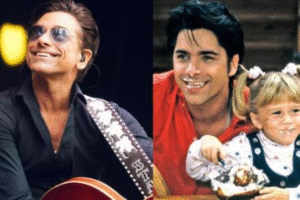
Working on Broadway required John to develop new skills—projecting to live audiences, maintaining energy and consistency through multiple performances, and collaborating with different types of creative professionals. These experiences enhanced his overall performing abilities and provided him with new creative challenges.
His Broadway work also demonstrated his commitment to continuing artistic growth rather than resting on his television success. The demanding nature of musical theater required him to maintain his physical condition and vocal abilities while mastering complex choreography and musical arrangements.
Television Guest Appearances and Character Exploration
During the 2000s, John made strategic guest appearances on various television shows that allowed him to explore different types of characters while trading on his established reputation. His appearances demonstrated his range while also showing his willingness to play with his own image and public persona.
His work on shows like “Thieves,” “Jake in Progress,” and various TV movies allowed him to experiment with different genres and character types. These projects provided him with opportunities to work with different directors and creative teams while maintaining his presence in the television landscape.
Some of his guest appearances specifically played with audience expectations about his “Full House” persona, demonstrating his sense of humor about his own career and his understanding of how public perception could be used as a creative tool.
Business Ventures and Producing
John began exploring the business side of entertainment during this period, developing his skills as a producer and understanding the financial and creative aspects of project development. This knowledge would prove valuable when “Fuller House” was being developed years later.
His involvement in producing projects allowed him to have greater creative control while also providing him with additional income streams beyond acting work. This business acumen demonstrated his understanding that successful entertainment careers require diversification and strategic planning.
His producing work also provided him with insights into different aspects of the entertainment industry, from development and financing to marketing and distribution. This comprehensive understanding enhanced his value as a creative collaborator and business partner.
Personal Relationships and Marriage
John’s relationship with model and actress Rebecca Romijn, whom he married in 1998, represented a significant personal milestone. Their marriage lasted until 2005 and provided him with stability during a period of career transition and professional uncertainty.
The relationship with Rebecca introduced John to different social and professional circles, expanding his network and providing him with new perspectives on the entertainment industry. Their high-profile marriage also required him to navigate increased media attention about his personal life.
The eventual end of their marriage was a personal setback that occurred during a period when John was already reassessing his career direction and personal priorities. The divorce process taught him about resilience and the importance of maintaining perspective during difficult personal transitions.
Chapter 5: Career Renaissance and Personal Growth (2007-2018)
The ER Success and Dramatic Credibility
John’s extended run on “ER” from 2005 to 2009 marked a significant turning point in his career, establishing him as a credible dramatic actor while providing him with steady work during a period of industry uncertainty. His character, Dr. Tony Gates, was complex and flawed, allowing John to demonstrate his range as a performer.
The role required him to master medical procedures and terminology while conveying the professional competence and personal struggles of an emergency room physician. His preparation for the role demonstrated his commitment to authenticity and his respect for the medical professionals his character represented.
Working alongside the established “ER” cast, including experienced dramatic actors like Maura Tierney and Mekhi Phifer, provided John with opportunities to learn from accomplished performers while contributing his own skills and perspective to the ensemble.
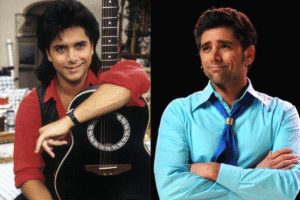
Return to Comedy and Guest Starring
After his “ER” success, John began selectively returning to comedy projects that interested him creatively rather than simply trading on his nostalgia value. His guest appearances on shows like “Entourage” and “The New Normal” demonstrated his ability to find humor in contemporary situations while maintaining his essential charm.
His approach to comedy during this period was more sophisticated than his earlier work, incorporating the life experience and dramatic skills he had developed over the years. This maturity enhanced his comedic performances by providing them with additional depth and authenticity.
These comedy projects also allowed John to work with new generations of performers and creative professionals, keeping him connected to current trends and sensibilities in television comedy while maintaining his relevance in the industry.
Personal Life Evolution and New Relationships
During this period, John’s personal life began stabilizing as he developed new relationships and reassessed his priorities following his divorce from Rebecca Romijn. His approach to dating became more private and thoughtful, reflecting lessons learned from his previous high-profile relationship.
His relationship with actress Caitlin McHugh began in the mid-2010s and represented a new chapter in his personal life. Caitlin’s understanding of the entertainment industry and her own acting career created a foundation for mutual support and understanding.
The development of this relationship coincided with John’s growing interest in settling down and potentially starting a family, marking a significant shift in his personal priorities and life goals.
Reunion Projects and Fuller House Development
John’s involvement in various “Full House” reunion projects during this period helped maintain audience interest in the property while also demonstrating his continued affection for his television family. These appearances showed that his relationships with his former cast members remained strong and genuine.
His role in developing “Fuller House” for Netflix was significant both creatively and business-wise. As an executive producer, John helped shape the reboot’s direction while ensuring it honored the original series’ values and quality standards.
The development process for “Fuller House” required John to balance nostalgia with contemporary relevance, ensuring that the new series would appeal to both original fans and new audiences. His involvement was crucial to the project’s success and credibility.
Health and Wellness Focus
During this period, John also began focusing more seriously on health and wellness, maintaining his physical condition and mental wellbeing as he entered his fifties. His commitment to fitness and healthy living became part of his public persona and personal philosophy.
His approach to aging in the public eye was positive and realistic, demonstrating that entertainment careers could continue evolving and growing even as performers moved into different life stages. This perspective influenced his approach to roles and projects during this period.
His wellness focus also included attention to work-life balance, ensuring that his professional commitments didn’t overwhelm his personal relationships and individual wellbeing. This balance became increasingly important as he prepared for the next phase of his life and career.
Chapter 6: Fuller House Era and Family Life (2016-2020)
Executive Producer Role and Creative Control
John’s return to the “Full House” universe through “Fuller House” represented more than just reprising a beloved character—it marked his evolution into a creative leader with significant input into the show’s direction and quality. His role as executive producer gave him influence over casting, storylines, and the overall tone of the reboot.

His experience in the entertainment industry and his understanding of what made the original series successful were invaluable during the development process. He helped ensure that “Fuller House” maintained the family-friendly values and authentic emotional connections that had made “Full House” a cultural phenomenon.
Working with Netflix also introduced John to new models of television production and distribution, expanding his understanding of how the entertainment industry was evolving in the streaming era. This knowledge enhanced his value as a creative professional and business partner.
Character Evolution and Maturation
Returning to Jesse Katsopolis after more than twenty years allowed John to explore how the character might have evolved and matured while maintaining his essential personality traits. Adult Jesse was still vain and music-obsessed, but he had gained wisdom and perspective that reflected John’s own personal growth.
The challenge of portraying an older version of Jesse required John to balance nostalgia with authentic character development. He needed to satisfy fans’ expectations while also creating a version of the character that felt genuine and age-appropriate.
His performance in “Fuller House” demonstrated how his own life experiences—marriage, relationships, professional challenges, and personal growth—had enhanced his ability to bring depth and authenticity to his character work.
Mentoring New Generation
John’s work on “Fuller House” also involved mentoring a new generation of young performers, including the children who played the next generation of the Tanner family. His experience from the original series made him uniquely qualified to help these young actors navigate the challenges of working in television.
His approach to mentoring was supportive and protective, drawing from his own experiences as a young performer and his observations of how the original child actors had been supported during “Full House.” This continuity helped maintain the positive working environment that had characterized the original series.
The intergenerational dynamic on “Fuller House” also provided John with opportunities to demonstrate how experience and wisdom could enhance rather than limit creative performance. His leadership helped bridge different generations of performers and creative professionals.
Marriage to Caitlin McHugh
John’s marriage to actress Caitlin McHugh in 2018 represented a significant personal milestone, providing him with partnership and stability as he entered his mid-fifties. Their relationship was built on mutual respect, shared professional understanding, and genuine affection.
The wedding itself was a celebration that brought together John’s professional and personal families, including many of his “Full House” cast members. This integration of his different life relationships demonstrated the authentic connections he had maintained throughout his career.
Caitlin’s support for John’s career and her understanding of the entertainment industry’s demands created a partnership that enhanced both their personal happiness and professional opportunities.
Fatherhood at 54
The birth of John’s son, Billy, in 2018, marked perhaps the most significant personal development of this period. Becoming a father at age 54 provided John with new perspectives on family, responsibility, and the passage of time.
His approach to fatherhood was informed by his years of working with children on television and his observations of family dynamics throughout his career. He brought both practical experience and genuine emotional commitment to his role as a parent.
The experience of raising a child during this stage of his life also provided John with new material and perspectives that enriched his performances and his understanding of family relationships.
Balancing Legacy and Innovation
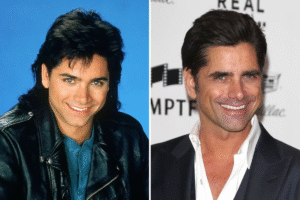
Throughout the “Fuller House” era, John successfully balanced respect for his legacy with openness to new creative opportunities. He demonstrated that returning to familiar roles didn’t have to mean creative stagnation if approached with intelligence and authentic emotion.
His work during this period showed how established performers could continue growing and contributing to their industry while honoring the work that had made them successful. This balance became a model for other actors considering similar career moves.
The success of “Fuller House” validated John’s belief that family entertainment remained relevant and valuable when it addressed contemporary challenges with honesty and humor while maintaining core values of love, support, and mutual respect.
Chapter 7: Recent Years and Continued Evolution (2020-Present)
Post-Fuller House Projects
Following the conclusion of “Fuller House” in 2020, John has continued to diversify his career with projects that showcase his range while building on his established reputation. His recent work demonstrates his commitment to continued growth as a performer and creative professional.
His guest appearances on various television shows and his involvement in different types of projects show that he remains interested in challenging himself creatively rather than simply repeating past successes. This approach keeps him relevant and engaged in an ever-changing entertainment landscape.
His selection of projects reflects both his professional judgment and his personal values, choosing work that aligns with his interests while also providing opportunities for artistic growth and meaningful collaboration with other creative professionals.
Social Media and Fan Engagement
John’s embrace of social media platforms has allowed him to maintain direct connections with fans while controlling his own narrative and public image. His social media presence showcases his humor, his family life, and his continuing professional activities.
His approach to social media is authentic and engaging, sharing glimpses of his personal life while maintaining appropriate boundaries. This balance demonstrates his understanding of how to use these platforms effectively without compromising his privacy or professional relationships.
The positive response to his social media content shows that his appeal transcends generational boundaries, with both longtime fans and new audiences appreciating his humor and authenticity.
Continued Musical Interests
John’s passion for music continues to be an important part of his life and career. His ongoing relationship with The Beach Boys and his involvement in various musical projects demonstrate that this aspect of his creativity remains vital and fulfilling.
His musical activities provide him with creative outlets that complement his acting work while also connecting him to different audiences and artistic communities. This diversification helps maintain his enthusiasm and prevents career stagnation.
The integration of his musical interests with his other professional activities shows how different aspects of his talent and personality can work together to create a more complete and satisfying career.
Family Life and Personal Priorities
John’s current focus on family life, particularly his role as a father to young Billy, has become central to his personal identity and public persona. His social media posts and interviews frequently feature his son and his experiences as an older father.
His approach to balancing career demands with family responsibilities reflects lessons learned throughout his life and career. He demonstrates how professional success can be meaningful when it supports rather than conflicts with personal values and relationships.

The joy he clearly takes in fatherhood has enhanced his public appeal while also providing him with new perspectives that enrich his creative work and personal satisfaction.
Industry Recognition and Legacy Building
Recent years have brought increased recognition of John’s contributions to entertainment, with retrospective appreciations of his work and acknowledgment of his influence on family television and popular culture.
His participation in reunion events, interviews, and documentaries about “Full House” and his other work demonstrates his comfort with his legacy while also showing his continued interest in creating new content and experiences.
The respect he has earned from industry professionals and the genuine affection he receives from fans reflect the authenticity and professionalism he has maintained throughout his long career.
Future Projects and Aspirations
John’s current approach to his career suggests that he remains open to new opportunities while being selective about projects that interest him creatively and align with his personal values. His recent work indicates continued ambition balanced with realistic assessment of his strengths and interests.
His involvement in developing new projects, both as a performer and producer, shows that he remains actively engaged in creating content rather than simply capitalizing on past successes. This forward-looking approach keeps him relevant and creatively satisfied.
His statements about future goals suggest that he intends to continue balancing professional achievement with personal fulfillment, demonstrating that successful careers can evolve and adapt while maintaining core values and relationships.
Conclusion: The Enduring Appeal of John Stamos
A Career Built on Authenticity
John Stamos’s enduring success in entertainment stems from his ability to remain authentically himself while adapting to different roles, genres, and career phases. His charm has never felt manufactured or calculated—it reflects genuine warmth, humor, and interest in connecting with others.
His career demonstrates that longevity in entertainment requires both talent and character. His reputation for professionalism, kindness, and collaborative spirit has sustained him through industry changes and personal challenges while earning him respect from colleagues and affection from audiences.
The consistency of his appeal across different decades and different types of projects shows that authentic charisma transcends changing trends and temporary fashions in entertainment.
Impact on Family Entertainment
John’s work on “Full House” and “Fuller House” has had lasting impact on how family entertainment is created and perceived. His portrayal of Jesse Katsopolis helped establish new models for how television could portray masculinity, family relationships, and personal growth.
His commitment to family-friendly content that doesn’t sacrifice intelligence or emotional honesty has influenced other performers and creators working in similar genres. His success proves that wholesome entertainment can be both commercially successful and artistically satisfying.
The values exemplified through his work—loyalty, growth, humor, and love—continue to resonate with audiences seeking content that celebrates rather than cynically examines human relationships and family bonds.
Personal Growth and Life Lessons
John’s personal journey from young heartthrob to mature family man provides inspiration for others navigating similar life transitions. His openness about his challenges and his commitment to continued growth demonstrate that success includes the ability to adapt and evolve.
His approach to aging in the public eye has been positive and realistic, showing that careers and personal satisfaction can continue developing throughout different life stages. His current happiness as a husband and father validates the choices he has made about balancing career and personal priorities.
The lessons from his life—the importance of authenticity, the value of persistence, the power of genuine relationships—provide guidance for anyone seeking to build meaningful careers and personal lives.
Legacy and Continuing Influence
John Stamos’s legacy extends beyond his individual performances to include his influence on how entertainment can celebrate family values while addressing real challenges and promoting personal growth. His work has touched multiple generations and continues to find new audiences.
His career serves as a model for how performers can maintain relevance and authenticity while adapting to industry changes and personal evolution. His success demonstrates that genuine talent combined with good character creates lasting appeal that transcends temporary trends.
As he continues his career and family life, John Stamos remains a beloved figure whose work and personal example continue to inspire and entertain audiences while demonstrating that the best entertainment comes from authentic human connection and genuine care for others.
The story of John Stamos is ultimately one of a person who found ways to use his talents and opportunities to create joy for others while building a meaningful life for himself—a legacy that extends far beyond any single role or achievement and continues to influence both the entertainment industry and the countless people who have been touched by his work.
